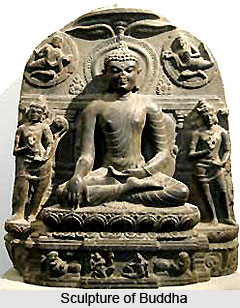 The Palas were the followers of Mahayana Buddhism. Their popular beliefs have resulted in the creation of several temples and works of art. Buddhism suffered a possibility of extinction after the reign of King Harsha Vardhana. But the coming of the Palas again popularised Buddhism as a religion in the Indian subcontinent. Religion during Pala Dynasty was characterized by Buddhism and Hinduism. The Palas were the devotees of Buddha and also worshipped the avatars of Vishnu. Various temples emerged during the Pala rule in Bengal, Bihar and Assam. According to history, the Hayagriva avatar temple in Assam was built by the Pala Dynasty. The Palas were constructed to have constructed a temple of the god Janardana (Krishna- Vishnu) also.
The Palas were the followers of Mahayana Buddhism. Their popular beliefs have resulted in the creation of several temples and works of art. Buddhism suffered a possibility of extinction after the reign of King Harsha Vardhana. But the coming of the Palas again popularised Buddhism as a religion in the Indian subcontinent. Religion during Pala Dynasty was characterized by Buddhism and Hinduism. The Palas were the devotees of Buddha and also worshipped the avatars of Vishnu. Various temples emerged during the Pala rule in Bengal, Bihar and Assam. According to history, the Hayagriva avatar temple in Assam was built by the Pala Dynasty. The Palas were constructed to have constructed a temple of the god Janardana (Krishna- Vishnu) also.
Religion during Pala Dynasty thus saw the emergence of Buddhism and they patronized Mahayana Buddhism. Mahayana is one of the major branches of Buddhism. Apart from India, this particular belief existed in the areas of China, Tibet, Japan, Korea, Vietnam, and Taiwan. It is during the Pala rule, the spread of Mahayana Buddhism occurred in the countries like Tibet, Nepal, Bhutan, Myanmar and the Indonesian archipelago. Several Buddhist scholars of the Pala Empire travelled from Bengal to the Far-East and propagated Buddhism. Outstanding Personalities such as Shantarakshit, Padmanava, Dansree, Bimalamitra, Jinamitra, Muktimitra, Sugatasree, Dansheel, Sambhogabajra, Virachan, Manjughosh and Atish Dipankar Srigyan travelled to the neighbouring countries for the extend of Buddhism.
The Pala Dynasty contributed a lot to the societies of Bengal, Bihar and Assam. Their belief and religious practise helped in the growth of universities of Vikramshila and Nalanda and became seats of learning for East Asia. In addition to that Religion during Pala Dynasty supported Vaishnavism as well as Saivism. Many coins found at the time of Pala period depicted the existence of Shiva worship, Vishnu Worship as well as Saraswati. Furthermore, substantial evidence proves that Pala dynasty also worshipped female deities. Several images of goddess of diverse types were worshipped. However, goddess worship was only confined to the Hindu segment in the society.
The long Pala period and the selected Religion during Pala Dynasty produced a commixture atmosphere of Hindu-Buddhist culture. This admixture resulted in the evolution of the sahajiya and tantrik cults. The Palas introduced a heritage of religious-social-cultural synthesis and this can be marked as the glorious achievement of the period and this attribute became a vital ingredient of ancient Bengal.






































